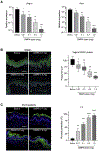Depot-medroxyprogesterone acetate reduces genital cell-cell adhesion molecule expression and increases genital herpes simplex virus type 2 infection susceptibility in a dose-dependent fashion
- PMID: 31302121
- PMCID: PMC6875619
- DOI: 10.1016/j.contraception.2019.07.003
Depot-medroxyprogesterone acetate reduces genital cell-cell adhesion molecule expression and increases genital herpes simplex virus type 2 infection susceptibility in a dose-dependent fashion
Abstract
Objective: Analyzing ectocervical biopsy tissue from women before and after they initiated use of depot-medroxyprogesterone acetate (DMPA), we previously reported this progestin reduces levels of the cell-cell adhesion molecule (CCAM) desmoglein-1 and increases genital mucosal permeability. We likewise saw treating mice with 1.0 mg of DMPA reduced vaginal CCAM expression and increased genital pathogen susceptibility. Herein, we used dose-response studies to delimit DMPA doses and serum MPA levels in mice associated with impaired genital mucosal barrier function and enhanced susceptibility to low-dose herpes simplex virus type 2 (HSV-2) infection.
Study design: We compared genital CCAM expression, genital mucosal permeability, and susceptibility to genital inoculation with 103 plaque-forming units of HSV-2 among mice in estrus vs. after treatment with 0.01 mg, 0.1 mg, 0.3 mg, or 1.0 mg of DMPA.
Results: Compared to mice in estrus, DMPA treatment in a dose-dependent fashion significantly reduced desmoglein 1α (Dsg1a) and desmocollin-1 (Dsc1) gene expression, reduced DSG1 protein levels, and increased genital mucosal permeability to a low molecular weight molecule. While no mice infected with HSV-2 in estrus died, we respectively saw 50% and 100% mortality in mice administered 0.1 mg or 0.3 mg of DMPA. At time of infection, mean serum MPA levels in mice administered the 0.1 mg or 0.3 mg doses were 3.8 nM and 13.0 nM respectively (values comparable to trough and peak MPA serum levels in women using DMPA).
Conclusions: Mice with pharmacologically relevant serum MPA concentrations display significant changes in genital CCAM expression, genital mucosal barrier function, and HSV-2 susceptibility.
Keywords: DMPA; Desmoglein-1; Genital HSV-2 infection; Genital mucosal barrier function.
Copyright © 2019 Elsevier Inc. All rights reserved.
Figures


Similar articles
-
Norethisterone Enanthate Increases Mouse Susceptibility to Genital Infection with Herpes Simplex Virus Type 2 and HIV Type 1.Immunohorizons. 2020 Feb 11;4(2):72-81. doi: 10.4049/immunohorizons.1900077. Immunohorizons. 2020. PMID: 32047094 Free PMC article.
-
Medroxyprogesterone acetate and levonorgestrel increase genital mucosal permeability and enhance susceptibility to genital herpes simplex virus type 2 infection.Mucosal Immunol. 2016 Nov;9(6):1571-1583. doi: 10.1038/mi.2016.22. Epub 2016 Mar 23. Mucosal Immunol. 2016. PMID: 27007679 Free PMC article.
-
Exogenous oestrogen inhibits genital transmission of cell-associated HIV-1 in DMPA-treated humanized mice.J Int AIDS Soc. 2018 Jan;21(1):e25063. doi: 10.1002/jia2.25063. J Int AIDS Soc. 2018. PMID: 29334191 Free PMC article.
-
An updated review on the effects of depot medroxyprogesterone acetate on the mucosal biology of the female genital tract.Am J Reprod Immunol. 2021 Sep;86(3):e13455. doi: 10.1111/aji.13455. Epub 2021 Jun 12. Am J Reprod Immunol. 2021. PMID: 33991137 Free PMC article. Review.
-
Research gaps in defining the biological link between HIV risk and hormonal contraception.Am J Reprod Immunol. 2014 Aug;72(2):228-35. doi: 10.1111/aji.12209. Epub 2014 Feb 19. Am J Reprod Immunol. 2014. PMID: 24548147 Free PMC article. Review.
Cited by
-
Estradiol-mediated enhancement of the human ectocervical epithelial barrier correlates with desmoglein-1 expression in the follicular menstrual phase.Front Endocrinol (Lausanne). 2024 Oct 8;15:1454006. doi: 10.3389/fendo.2024.1454006. eCollection 2024. Front Endocrinol (Lausanne). 2024. PMID: 39439565 Free PMC article.
-
Use of calibrated filter paper to evaluate vaginal moisture in mice.Sci Rep. 2025 May 30;15(1):19038. doi: 10.1038/s41598-025-02480-3. Sci Rep. 2025. PMID: 40447658 Free PMC article.
-
Ovariectomized mice and postmenopausal women exhibit analogous loss of genital epithelial integrity.Tissue Barriers. 2021 Apr 3;9(2):1865760. doi: 10.1080/21688370.2020.1865760. Epub 2021 Jan 11. Tissue Barriers. 2021. PMID: 33427560 Free PMC article.
-
NET-EN treatment leads to delayed HSV-2 infection, enhanced mucin and T cell functions in the female genital tract when compared to DMPA in a preclinical mouse model.Front Immunol. 2024 Nov 6;15:1427842. doi: 10.3389/fimmu.2024.1427842. eCollection 2024. Front Immunol. 2024. PMID: 39569191 Free PMC article.
-
Spatial transcriptomics unveils estrogen-modulated immune responses and structural alterations in the ectocervical mucosa of depot medroxyprogesterone acetate users.Sci Rep. 2025 Jan 6;15(1):1014. doi: 10.1038/s41598-024-83775-9. Sci Rep. 2025. PMID: 39762272 Free PMC article.
References
-
- Evidence for Contraceptive Options and HIV Outcomes (ECHO) Trial Consortium. HIV incidence among women using intramuscular depot medroxyprogesterone acetate, a copper intrauterine device, or a levonorgestrel implant for contraception: a randomised, multicentre, open-label trial. Lancet. 2019. June 13 pii: S0140-6736(19)31288-7. 10.1016/S0140-6736(19)31288-7 - DOI - PMC - PubMed
-
- Quispe Calla NE, Vicetti Miguel RD, Boyaka PN, Hall-Stoodley L, Kaur B, Trout W, et al. Medroxyprogesterone acetate and levonorgestrel increase genital mucosal permeability and enhance susceptibility to genital herpes simplex virus type 2 infection. Mucosal Immunol. 2016. November; 9(6):1571–1583. 10.1038/mi.2016.22 - DOI - PMC - PubMed
Publication types
MeSH terms
Substances
Grants and funding
LinkOut - more resources
Full Text Sources
Medical
Molecular Biology Databases

